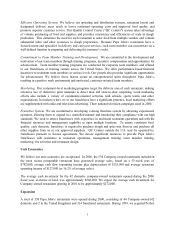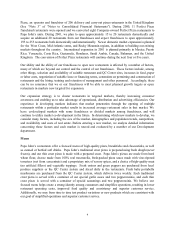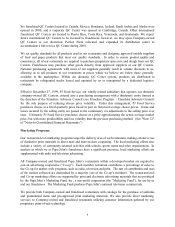Papa Johns 2000 Annual Report Download - page 18
Download and view the complete annual report
Please find page 18 of the 2000 Papa Johns annual report below. You can navigate through the pages in the report by either clicking on the pages listed below, or by using the keyword search tool below to find specific information within the annual report. 13
This Form 10-K contains forward looking statements within the meaning of the Private Securities
Litigation Reform Act of 1995 (the “Act”), including information within Management’ s Discussion and
Analysis of Financial Condition and Results of Operations. The following cautionary statements are being
made pursuant to the provisions of the Act and with the intention of obtaining the benefits of the “safe
harbor” provisions of the Act. Although we believe that our expectations are based on reasonable
assumptions, actual results may differ materially from those in the forward looking statements as a result
of various factors, including but not limited to, the following:
1. Our ability and the ability of our franchisees to continue to expand through the opening of new
restaurants is affected by a number of factors, many of which are beyond our control and our franchisees’
control. These factors include, among other things, selection and availability of suitable restaurant
locations, increases in food, paper and labor costs, negotiation of suitable lease or financing terms,
constraints on permitting and construction of other restaurants, higher than anticipated construction costs,
and the hiring, training and retention of management and other personnel. Accordingly, there can be no
assurance that we or the Papa John’ s franchisees will be able to meet planned growth targets, open
restaurants in markets now targeted for expansion, or continue to operate in existing markets.
2. The restaurant industry is intensely competitive with respect to price, service, location and food
quality, and there are many well-established competitors with substantially greater financial and other
resources than Papa John’ s and our franchisees. Some of these competitors have been in existence for a
substantially longer period than us or our franchisees and may be better established in the markets where
restaurants operated by Papa John’ s or our franchisees are, or may be, located. A change in the pricing
or other marketing or promotional strategies of one or more of our major competitors could have an
adverse impact on sales and earnings at restaurants operated by us and our franchisees.
3. An increase in the cost of cheese or other commodities could adversely affect the profitability of our
restaurant operations. Cheese, representing approximately 35 to 40% of our food cost, and other
commodities are subject to seasonal fluctuations, weather, availability, demand and other factors that are
beyond our control. Additionally, sustained increases in fuel costs could adversely affect profitability of our
restaurant and QC Center businesses.
4. Changes in consumer taste, demographic trends, traffic patterns and the type, number and location
of competing restaurants could adversely affect our restaurant business.
5. Our restaurant operations are subject to federal and state laws governing such matters as wages,
working conditions, citizenship requirements and overtime. A significant number of hourly personnel
employed by us and our franchisees are paid at rates related to the federal minimum wage. Accordingly,
further increases in the minimum wage will increase labor costs for us and our franchisees. Additionally,
labor shortages in various markets could result in higher required wage rates.
6. Our international operations are subject to a number of additional factors, including international
economic and political conditions, currency regulations and fluctuations, differing cultures and consumer
preferences, diverse government regulations and structures, availability and cost of land and construction,
and differing interpretation of the obligations established in franchise agreements with international
franchisees. Accordingly, there can be no assurance that our international operations will achieve or
maintain profitability or meet planned growth rates.
























